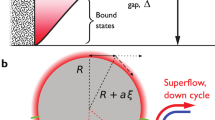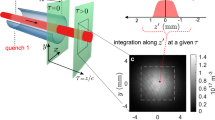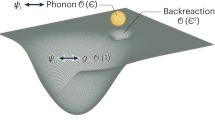Abstract
IN cosmology a continuous fluid is used to represent the complex contents of the universe. Homogeneous and isotropic models then show that the universe originated from a space–time singularity of infinite density some 1010 years ago1. Before accepting singularities of infinite density we must ask whether the continuous fluid models are realistic representations of an early dense universe. Given that an infinite density is possible in a continuous fluid, does it also follow that an infinite density is possible in a fluid consisting of particles ?
This is a preview of subscription content, access via your institution
Access options
Subscribe to this journal
Receive 51 print issues and online access
$199.00 per year
only $3.90 per issue
Buy this article
- Purchase on SpringerLink
- Instant access to full article PDF
Prices may be subject to local taxes which are calculated during checkout
Similar content being viewed by others
References
Robertson, H. P., Rev. Mod. Phys., 5, 62 (1953). Bondi, H., Cosmology (Cambridge University Press, Cambridge, England, 1960). Departures from homogeneity and isotropy apparently do not prevent the occurrence of singularities in cosmology as shown by Hawking, S. W., Proc. Roy. Soc., A, 294, 511 (1966); A, 295, 490 (1966).
Rindler, W., Mon. Not. Roy. Astro. Soc., 116, 662 (1956).
Harrison, E. R., Astron. J. (in the press).
Wigner, E. P., Rev. Mod. Phys., 29, 255 (1957). Bergmann, P. G., and Komar, A. B., Recent Developments in General Relativity (Pergamon, London, 1962). Anderson, J. L., Relativity and Gravitation (edit. by Chiu, H. Y., and Hoffmann, W. F.) (Benjamin, New York, 1964).
Landau, L. D., Niels Bohr and the Development of Physics (edit. by Pauli, W.) (Pergamon, London, 1955).
Planck, M., Theory of Heat Radiation, 175 (Dover, 1959).
Harrison, B. K., Thorne, K. S., Wakano, M., and Wheeler, J. A., Gravitation Theory and Gravitational Collapse (Chicago University Press, Chicago, 1965).
Wheeler, J. A., Ann. Phys., 2, 604 (1957).
These conclusions presumably also apply to the ultimate fate of large masses in gravitational collapse: Harrison, B. K., Wakano, M., and Wheeler, J. A., La Structure et l'Evolution de l'Univers (Stoops, Brussels, 1958). Wheeler, J. A., Relativity and Gravitation (edit. by Chiu, H. Y., and Hoffmann, W. F. ) (Benjamin, New York, 1963). Harrison, B. K., Thorne, K. S., Wakano, M., and Wheeler, J. A., Gravitation Theory and Gravitational Collapse (Chicago University Press, Chicago, 1965).
Author information
Authors and Affiliations
Rights and permissions
About this article
Cite this article
HARRISON, E. Quantum Cosmology. Nature 215, 151–152 (1967). https://doi.org/10.1038/215151c0
Received:
Revised:
Issue date:
DOI: https://doi.org/10.1038/215151c0
This article is cited by
-
A broken-symmetry theory of gravity
General Relativity and Gravitation (1988)
-
Cosmological hadronic fireball
Astrophysics and Space Science (1973)
-
Closed cosmological solutions to Einstein’s field equations
Lettere Al Nuovo Cimento Series 2 (1972)
-
Physical Sciences: Are Protars Spinars?
Nature (1971)
-
Comments on the Big-bang
Nature (1970)



